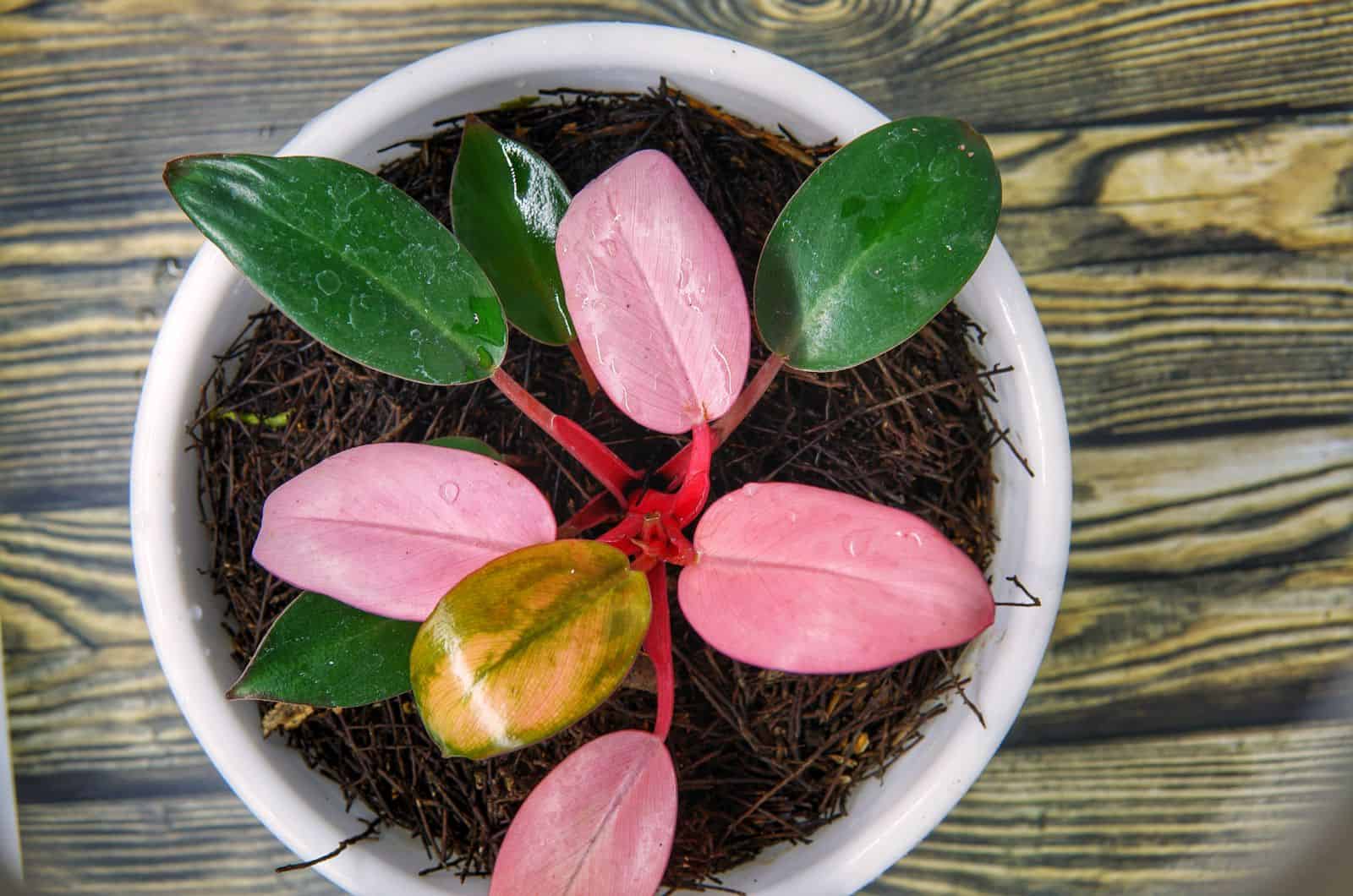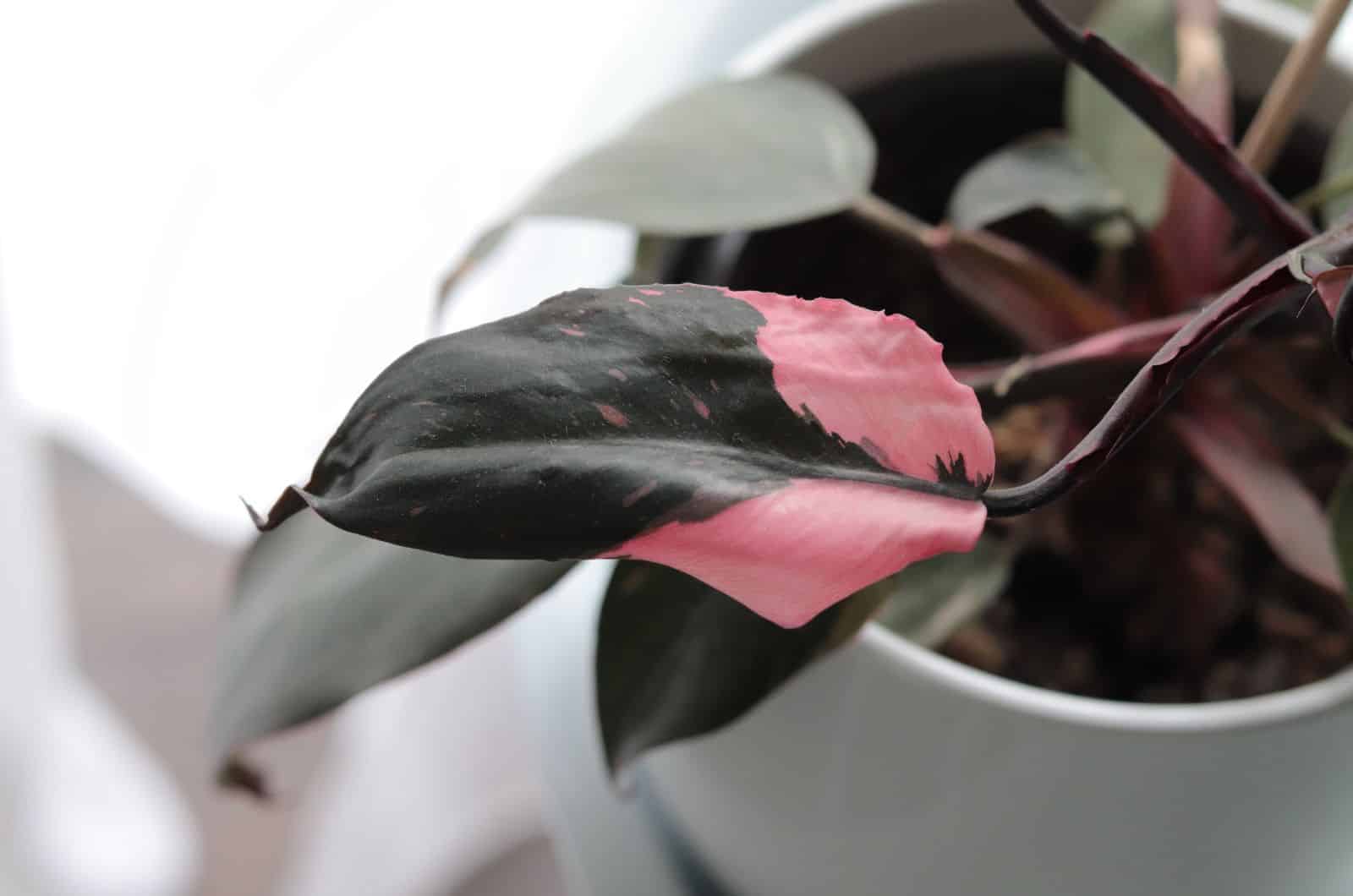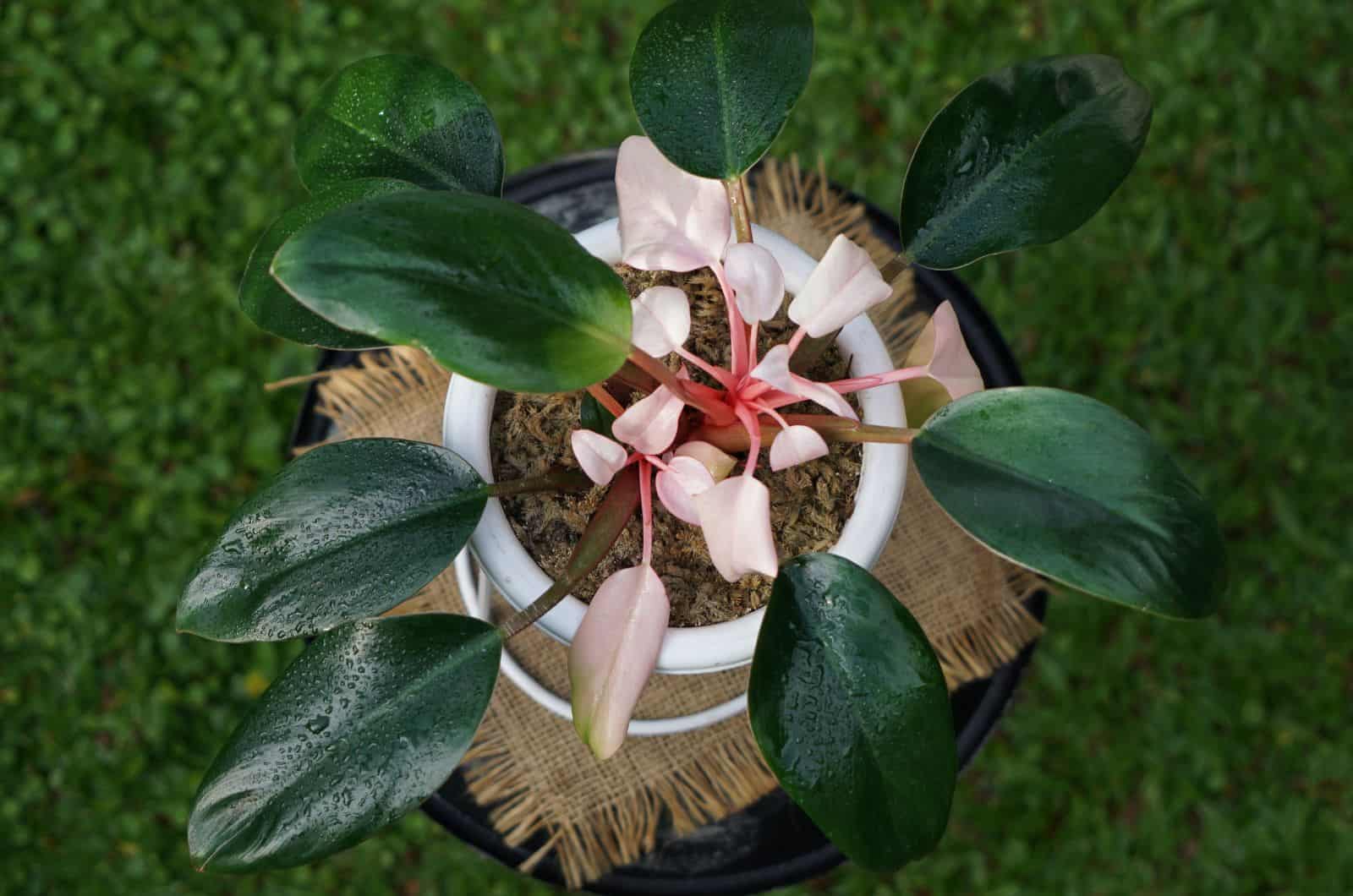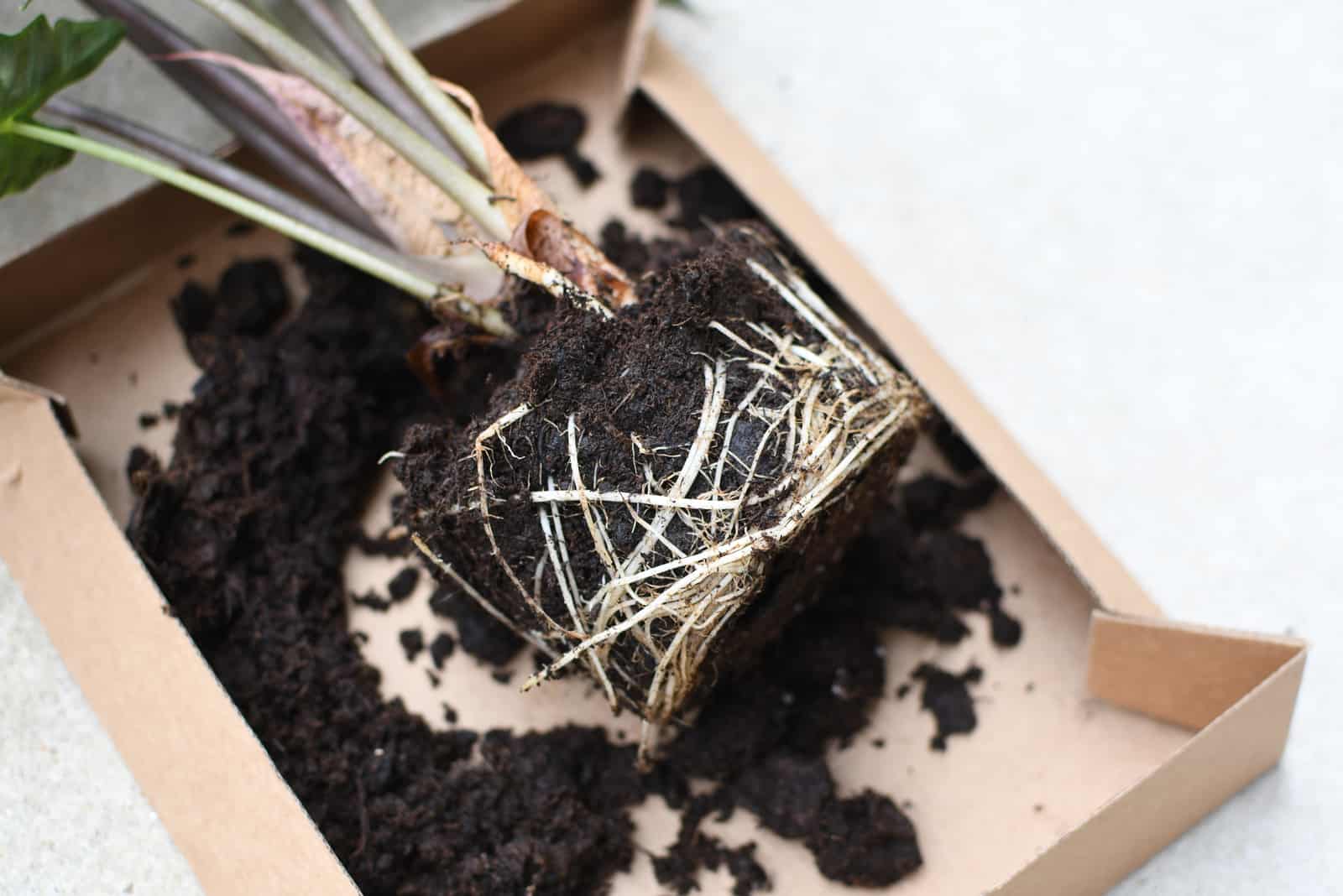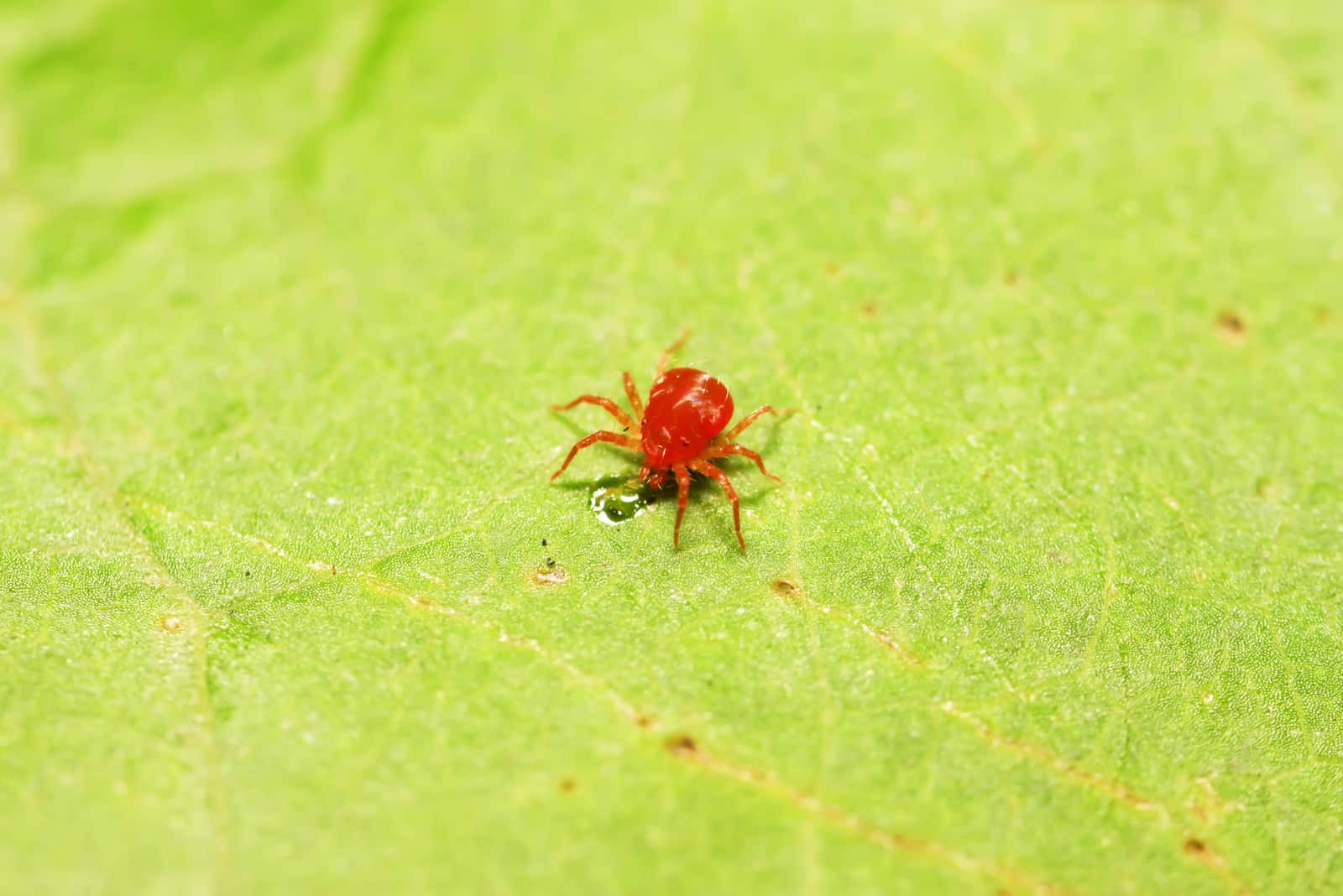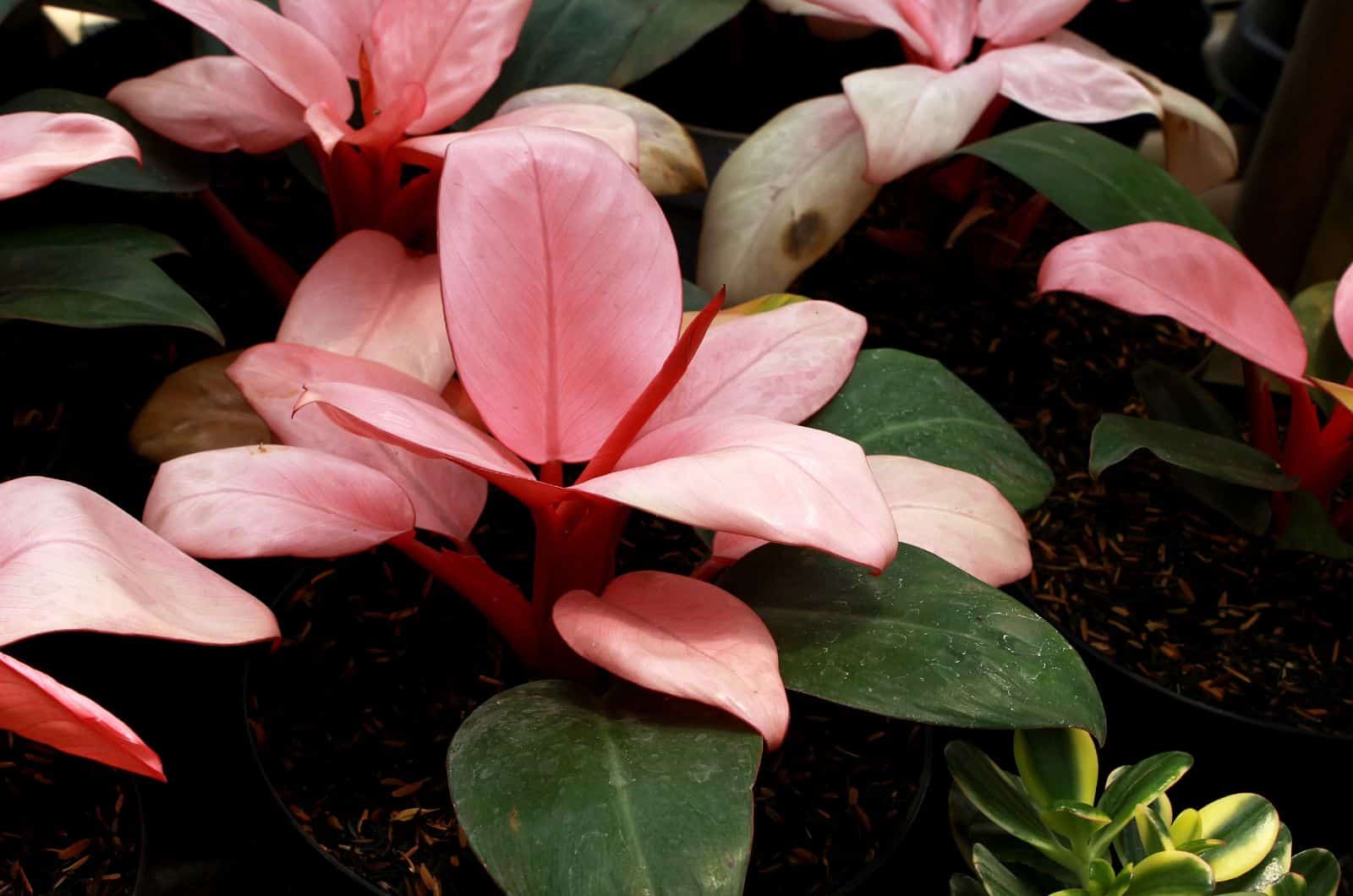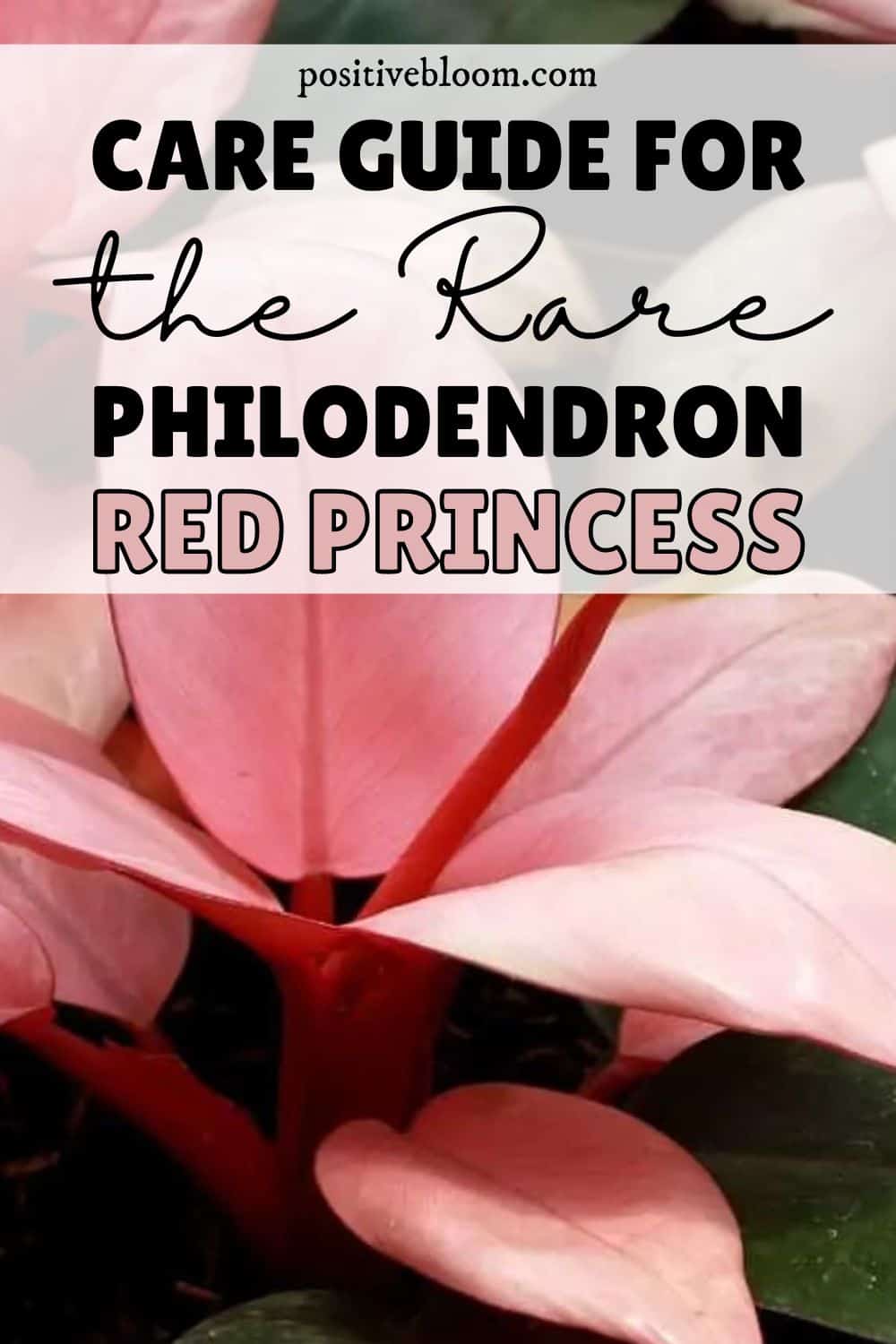Welcome to the princess diaries!
And no, I’m not talking about the movie — we are focusing solely on the plant known as Philodendron Red Princess!
There are already over 400 different Philos varieties, and botanists want to expand the Philodendron family even further by crossing different varieties and obtaining brand new hybrid plants.
In order to develop an offspring, or hybrid, that combines the best qualities of both parents, plant breeders purposefully cross-pollinate two distinct types of plant.
This is how we are now able to grow the beautiful Philodendron Red Princess, which has become quite popular nowadays; you can often see their pink leaves decorating offices and homes.
Let’s learn more about this type of philodendron, and also how to take care of it!
What Is The Philodendron Red Princess?
As we already mentioned, the Philodendron Red Princess is a hybrid plant that produces large variegated aspidistra leaves. The eye-catching pink patches on the leaves are excellent for providing a subtle pop of color in your room, which is why this plant is so often the interior designer’s choice.
Sometimes whole leaves can turn pink or red, and you will have a plant that produces leaves in two different colors!
The Red Princess Philodendron plant can also produce flowers when grown in the right conditions. Though these fresh flowers can appear at any time of year, they usually appear as summer flowers or not at all!
These tiny flowers make the plant even more aesthetically pleasing, though you don’t have to worry about your Philodendron Red Princess not producing flowers – it’s really not that big of a deal.
Even though this plant produces flowers, the pink leather leaves are the main reason plant enthusiasts and interior designers absolutely love this little princess!
As well as this, they are also used for making various flower arrangements and flower delivery because the pink leaves look absolutely great with variegated pittosporum, purple statice, eucalyptus, carnations, red roses, yellow gerberas, and hydrangeas.
Growth Habits
Similarly to another royal plant, known as the Philodendron Dark Lord, the princess Philo is a fast-growing climber. This tropical plant can climb and cling to anything nearby because of its strong roots! You have the option of using a moss pole or one of the many moss pole alternatives.
As it’s a fast grower, I recommend you grow them in a pot or hanging basket.
Philodendron Red Princess Care Guide
Philodendron plants are known for being low-maintenance plants suitable for beginner gardeners.
The same thing applies to our little princess — this Philo thrives in partial shade, which also makes it a perfect plant for offices where there is little to no light.
Let’s look at what it takes to make this plant happy!
Soil Requirements
This rare aroid plant prefers nutrient-rich, loose, and well-draining soil.
Perlite, orchid bark, sphagnum moss, and common potting mix make up the ideal potting mixture. These materials can be combined in equal proportions to make your little princess plant absolutely ecstatic!
This mixture will maintain the soil’s moisture, but not to the point where it gets compact. To prevent root rot, stay away from soggy and sandy soils!
Water Requirements
The soil shouldn’t be too dry or too moist for this precious hybrid Philo — somewhere in-between is perfect. To avoid using too much water and ending up with soggy soil, allow the soil to dry out before watering it again.
Don’t let the soil dry out completely though!
Dry soil can cause stunted growth, which prevents your plant from reaching its full potential.
Temperature conditions have a major impact on the watering schedule. The plant will dry up quicker and you might need to water it more frequently if the temperature is higher.
The water needs of your plant are drastically reduced during the winter months. This is because the soil needs more time to dry as water evaporates more slowly.
The best course of action would be to maintain ideal conditions indoors, as watering requirements won’t change if temperatures don’t fluctuate.
Use your thumb or a wooden stick to see if the soil is completely dry before watering.
Light Requirements
As we mentioned earlier, this rare exotic plant thrives in bright indirect light. In most cases, the Philodendron Red Princess is grown in offices, though they are sometimes used by florists to create beautiful flower arrangements and wedding flowers!
Keep your new plant away from direct sunlight if you plan to grow it outside (you can plant it in the shade under a large tree).
If you keep your philodendron indoors, it will almost certainly improve the design of a corner of your room – just make sure it is situated at an appropriate distance from the windows so it grows big and healthy without getting sunburned.
Fertilizer Requirements
You should fertilize your Red Princess Philodendron occasionally to make it healthy and happy.
Because this plant is robust and doesn’t require as much fertilizer as other houseplants, it is advised to use only 1/4 of the usual amount.
When caring for your plants, you should add fertilizer once a month in the spring and summer. Please refrain from using too much fertilizer as it can cause salt to accumulate in the soil.
What Is The Best Fertilizer For A Philodendron Red Princess?
The elements that make life possible are oxygen, carbon, nitrogen, and hydrogen, however, this does not imply that the other elements are not equally significant.
For example, plants benefit from phosphorus and potassium, so you should choose a fertilizer that contains these components.
The best fertilizers are those that can be diluted with water, such as liquid fertilizers. Liquid fertilizers should definitely be on your shopping list if you intend to purchase a philodendron plant.
Temperature Requirements
The Philodendron Red Princess is a hybrid plant made by crossing two tropical plants, which means that this Philo is also a tropical plant – and tropical regions are warm and humid!
The Philodendron Red Princess grows best between 60 to 75 degrees Fahrenheit and doesn’t handle temperature changes very well.
Any temperature below this range can harm your plant, especially if it freezes. Philodendrons are not frost-resistant and cannot withstand cold temperatures.
Humidity Requirements
We’ll now look at humidity because it can be challenging to provide your tropical plants with ideal humidity levels.
Philodendrons can tolerate lower humidity levels, but I’m sure you want what’s best for your plant, and higher humidity gives it that unique humidity glow!
I know it’s a lot, and sometimes it can be challenging to achieve this level in your own home, but the Philodendron Red Princess enjoys growing in an atmosphere with 70% humidity.
It shouldn’t be too difficult to increase the humidity levels in your home if you want to provide your plant with the best conditions possible.
Here are some tips for improving humidity levels in your house:
Create A Pebble Tray
You can increase humidity with this straightforward technique, which only needs three things: pebbles, a tray, and some water.
Fill the tray with pebbles and add water, being careful to prevent the pebbles from being completely submerged.
Your Philodendron plant should now be placed directly on top of the tray. As the water evaporates, it will provide humidity for your plant.
Group The Plants
The second technique, which is also the least expensive, is to group your plants. This works great with Monsteras, Pothos, some other Philodendrons like the Philodendron Camposportoanum, or another rare Philodendron variety.
This will both make your space more attractive and aid in the even distribution of humidity.
Invest In A Humidifier
You can get yourself a humidifier if you prefer to use technology to fix your problems. Despite the fact that these gadgets are pricey, they are worthwhile because you won’t have to worry about humidity at all. Your plant will grow more robustly and healthily as a result of humidity being monitored and increased by a humidifier.
You could also try misting your Philodendron, but be careful to let the leaves dry fully because if water is left on them for too long it can cause them to wilt or decay.
Find A New Place For Your Plant
Moving your Philodendron to a different room is another free option. For instance, you can put it in a kitchen or bathroom because those rooms typically have greater humidity levels and are great settings for Philos. It also works great because bathrooms don’t usually get enough light.
Repotting
These plants are known for being fast-growers, and once they have outgrown their original pot they must be replanted. How can you tell when it is time to repot your little princess plant?
As a plant’s roots tend to stick out when they don’t have enough room, you should first examine the drainage holes in the bottom of the pot.
Early spring is the best time to repot this plant, and it should go into a pot that is just a little bit bigger than the old one because too much extra room makes the plant more vulnerable to pests and diseases.
Pruning
Pruning is not a necessary step in this philodendron care guide, which is fortunate because it would be extremely difficult to remove those lovely pink leaves!
In order to prevent the spread of diseases, you should remove any damaged or infected leaves immediately, however.
Propagation
Once you’ve mastered propagation, the Philodendron Red Princess won’t be such a rare plant any longer!
This plant is usually propagated with the air-layering method. Air layering involves covering the stem in damp moss to assess the development of new roots.
Carefully follow the instructions below to propagate your Philodendron Red Princess with the air layering technique:
1. The first thing you need to do is search for a suitable stem with some aerial roots.
2. Next, using a sanitized knife, make a shallow cut in the stem about two inches deep.
3. To keep the wound open, insert a toothpick through the top and bottom (it has to be open for the sphagnum moss).
4. Prepare the sphagnum moss by placing it in a plastic bag filled with distilled water.
5. Cover the wound with sphagnum moss.
6. Wrap the sphagnum moss in plastic, being careful not to wrap it too tightly as this will restrict air flow, which is necessary for the emergence of new roots. To prevent the sphagnum moss from falling out, don’t wrap it too loosely either. To keep the wrap in place, put some duct tape around it.
7. It will take your new baby plant roughly three weeks to grow. You might want to prepare fresh potting soil and purchase a new plant pot in the meantime (make sure that it has drainage holes in the bottom).
8. The new plant should be separated from the mother plant when you see that the roots have grown to around 4 inches long. Cut a few inches below the injured region with a sterilized knife or pair of gardening shears.
9. Remove the plastic wrap gently so as not to harm the newly planted roots. Place it in an adequate potting soil. To encourage it to grow, you can add fertilizer.
For clearer instructions, check out this video: https://youtu.be/3kylsQDqyA0
Common Problems With The Philodendron Red Princess
Even though this is a hybrid plant that is cultivated primarily for its finest traits, we can’t have it all. Your Princess Philodendron is unfortunately toxic and prone to various pests and diseases.
Let’s take a look at the common pests and diseases that can affect this plant’s health.
Toxicity
The toxic nature of philodendron plants is their biggest drawback. Philodendron plants have trace amounts of calcium oxalate crystals, and even though they pose little risk to adults, it can be toxic if consumed by animals or young children.
This plant can cause vomiting, bloating, and mouth burning.
If your children or pets unintentionally ingest the plant, I advise you to contact medical professionals or a vet immediately.
Pest & Diseases
The Philodendron Red Princess won’t have such major issues when it comes to pests and diseases.
However, it is prone to some pests like spider mites, mealybugs and scales, as well as to diseases like bacterial leaf spot, root rot, and dasheen mosaic virus.
Spider Mites
If you notice little webs all over your philodendron plant, you’ll need to act immediately because you are probably dealing with spider mites.
These little pests like dry and warm environments, which is why they often hide under the leaves and steal your plant‘s nutrients!
To get rid of them, you can either use pesticides or neem oil, though you can also use insecticidal soap or just wash them away (though this is not as effective).
Mealy Bugs
Mealy bugs suck on sap from your plant and secrete sticky honeydew, which usually attracts ants on some plants, but they can also infest your Philodendron Red Princess!
These bugs usually cause yellowing of the leaves, though any type of discoloration could be a sign of a mealy bug infestation.
It can be tiring to fight these little annoyances, and if you notice that your plant is heavily infected, you should immediately isolate it to prevent spreading and discard it.
However, if you are only dealing with a mild infestation, you can use rubbing alcohol, insecticidal soap, or horticultural oil to fight them off.
Scales
Scales have distinctive brown and disc-shaped bodies. These insects occasionally have a waxy coating that gives them the appearance of white cottony tufts stuck to the leaves and stems of the plant. These bugs adore eating plants and will take all of their nutrients!
Scales are typically removed by vigorously spraying them off plants. If the infestation is severe or the insects come back, an application of insecticidal soap can be necessary.
Bacterial Leaf Spot
Your plant may have bacterial leaf spot disease if the edges of the leaves have turned dark with yellow aureoles. When the bacteria get to the petioles, the leaves will droop.
Pseudomonas bacteria are the culprits behind bacterial leaf spot disease, and they leave behind tiny blotches and holes in the leaves.
The best way to get rid of bacterial leaf spot is by removing the infected leaves and using neem oil or fungicides to treat it. You should also avoid getting the leaves wet if your plant has been infected.
Root Rot
Overwatering causes the soil to get soggy, which attracts fungus and bacteria that can settle in nicely in that wet and warm environment!
You may be dealing with root rot if you see any stunted growth or yellowing and wilting of the leaves.
Repot your plant and cut out the rotting roots with sterile gardening shears in this case.
Dasheen Mosaic Virus
One of the major viral pathogens of C. esculenta is dasheen mosaic virus (DsMV), which manifests as pale green feathering symptoms, severe or mild vein-banding symptoms, or no symptoms at all. The virus alters the color, size, and shape patterns of the leaves, and it may also lower corm yield. Symptoms frequently manifest intermittently or seasonally.
Unfortunately, there are no chemical controls or pesticides that can treat this disease. You’ll have to dig up and destroy the infected plants in order to stop the disease from spreading to your other plants.
Frequently Asked Questions
1. Why is the Philodendron Pink Princess so rare?
The main reason this Philodendron plant is so rare is because it’s a hybrid plant, which means that it doesn’t grow in nature. This makes hybrid plants hard to get!
2. How do you take care of a Red Philodendron?
The Red Philodendron is a beginner-friendly plant, which means that it isn’t that hard to take care of. All you have to do is keep the plant warm, provide it with well-draining soil, and fertilize it every now and then.
Give your Philo plant water when its soil is dry and put them in an area with partial shade, and it will be happy and healthy!
3. How long does it take to grow a Philodendron?
Generally, all Philodendrons are pretty fast growers. Of course, the rate of growth can vary between the species, though they usually grow 4 inches a week during their growing season.
To Sum Up
The Philodendron Red Princess is truly a beautiful plant that can decorate any room, office, or garden!
Even though we are talking about a hybrid plant, it has the same requirements as a normal Philodendron plant and is susceptible to similar pests and diseases.
The plant care guide is the same as for any other Philodendron; provide them with adequate temperature and humidity, fertilize them with a balanced fertilizer during the growing season, and grow them in loose and well-draining soil.
This is what it takes to keep your plant healthy and thriving!
Because the Philodendron Red Princess is pretty rare, I would recommend you propagate it and gift it to someone special!
Until next time
Like this post? Share or pin it for later!

